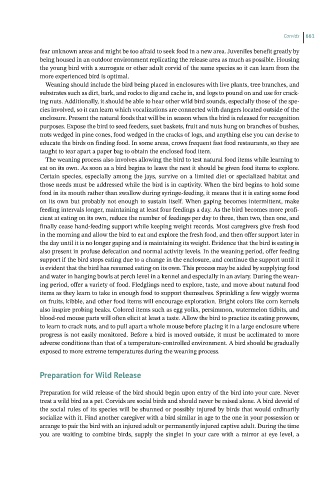Page 660 - Hand rearing birds second
P. 660
Corvids 661
fear unknown areas and might be too afraid to seek food in a new area. Juveniles benefit greatly by
being housed in an outdoor environment replicating the release area as much as possible. Housing
the young bird with a surrogate or other adult corvid of the same species so it can learn from the
more experienced bird is optimal.
Weaning should include the bird being placed in enclosures with live plants, tree branches, and
substrates such as dirt, bark, and rocks to dig and cache in, and logs to pound on and use for crack-
ing nuts. Additionally, it should be able to hear other wild bird sounds, especially those of the spe-
cies involved, so it can learn which vocalizations are connected with dangers located outside of the
enclosure. Present the natural foods that will be in season when the bird is released for recognition
purposes. Expose the bird to seed feeders, suet baskets, fruit and nuts hung on branches of bushes,
nuts wedged in pine cones, food wedged in the cracks of logs, and anything else you can devise to
educate the birds on finding food. In some areas, crows frequent fast food restaurants, so they are
taught to tear apart a paper bag to obtain the enclosed food item.
The weaning process also involves allowing the bird to test natural food items while learning to
eat on its own. As soon as a bird begins to leave the nest it should be given food items to explore.
Certain species, especially among the jays, survive on a limited diet or specialized habitat and
those needs must be addressed while the bird is in captivity. When the bird begins to hold some
food in its mouth rather than swallow during syringe-feeding, it means that it is eating some food
on its own but probably not enough to sustain itself. When gaping becomes intermittent, make
feeding intervals longer, maintaining at least four feedings a day. As the bird becomes more profi-
cient at eating on its own, reduce the number of feedings per day to three, then two, then one, and
finally cease hand-feeding support while keeping weight records. Most caregivers give fresh food
in the morning and allow the bird to eat and explore the fresh food, and then offer support later in
the day until it is no longer gaping and is maintaining its weight. Evidence that the bird is eating is
also present in profuse defecation and normal activity levels. In the weaning period, offer feeding
support if the bird stops eating due to a change in the enclosure, and continue the support until it
is evident that the bird has resumed eating on its own. This process may be aided by supplying food
and water in hanging bowls at perch level in a kennel and especially in an aviary. During the wean-
ing period, offer a variety of food. Fledglings need to explore, taste, and move about natural food
items as they learn to take in enough food to support themselves. Sprinkling a few wiggly worms
on fruits, kibble, and other food items will encourage exploration. Bright colors like corn kernels
also inspire probing beaks. Colored items such as egg yolks, persimmon, watermelon tidbits, and
blood-red mouse parts will often elicit at least a taste. Allow the bird to practice its eating prowess,
to learn to crack nuts, and to pull apart a whole mouse before placing it in a large enclosure where
progress is not easily monitored. Before a bird is moved outside, it must be acclimated to more
adverse conditions than that of a temperature-controlled environment. A bird should be gradually
exposed to more extreme temperatures during the weaning process.
Preparationfor WildRelease
Preparation for wild release of the bird should begin upon entry of the bird into your care. Never
treat a wild bird as a pet. Corvids are social birds and should never be raised alone. A bird devoid of
the social rules of its species will be shunned or possibly injured by birds that would ordinarily
socialize with it. Find another caregiver with a bird similar in age to the one in your possession or
arrange to pair the bird with an injured adult or permanently injured captive adult. During the time
you are waiting to combine birds, supply the singlet in your care with a mirror at eye level, a

